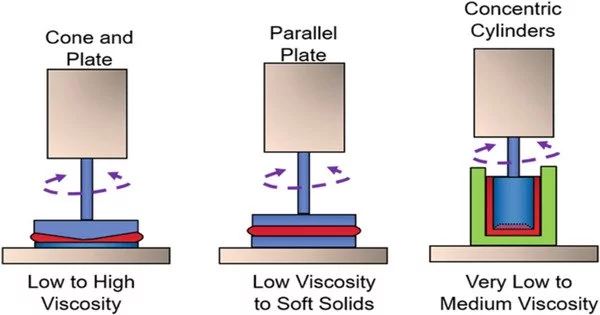Rheometry refers to the experimental techniques used to determine the rheological properties of materials, that is, the qualitative and quantitative relationships between stresses and strains and their derivatives. It is a scientific technique used to study the flow and deformation behavior of materials, particularly fluids and soft solids, under applied forces or strains. The techniques used are experimental. Rheometry studies materials in relatively simple flows such as steady shear flow, small amplitude oscillatory shear, and extensional flow. It involves measuring and analyzing the rheological properties of materials, which describe their flow and deformation characteristics.
The word “rheometry” is derived from the Greek word “rheo,” meaning “to flow,” and “metry,” meaning “measurement.” Rheometers are the instruments used for rheometry experiments. They apply controlled forces or deformations to materials and measure the resulting response, allowing researchers to understand the material’s flow properties and its response to applied stress.
The appropriate experimental technique is determined by the rheological property that needs to be determined. This can be the steady shear viscosity, the linear viscoelastic properties (complex-viscosity vs. elastic-modulus), the elongational properties, and so on. The measured property of all real materials will be a function of the flow conditions under which it is measured (shear rate, frequency, etc.), even if for some materials this dependence is vanishingly low under given conditions.
Application
Rheometry is widely used in various fields, including materials science, physics, chemistry, engineering, and biology, where understanding the behavior of complex fluids and soft materials is important. Some common applications of rheometry include:
- Quality control: Rheometry is used to characterize the flow properties of materials in industries such as cosmetics, food processing, pharmaceuticals, and paints. It helps ensure consistent product quality and optimize manufacturing processes.
- Biological and biomedical research: Rheometry is used to study the viscoelastic properties of biological fluids, such as blood, mucus, and synovial fluid. It helps in understanding their functions, diseases, and developing drug delivery systems.
- Polymer science: Rheometry plays a vital role in characterizing the rheological properties of polymers, such as viscosity, elasticity, and viscoelastic behavior. This information is important for polymer processing, product development, and performance evaluation.
- Geological studies: Rheometry helps in studying the flow properties of geological materials like magma, lava, and sediment. It provides insights into their behavior during volcanic eruptions, landslides, and other geological processes.
Overall, rheometry is a versatile and powerful tool for investigating the flow and deformation properties of materials, and it has broad applications in diverse scientific and industrial fields.
















